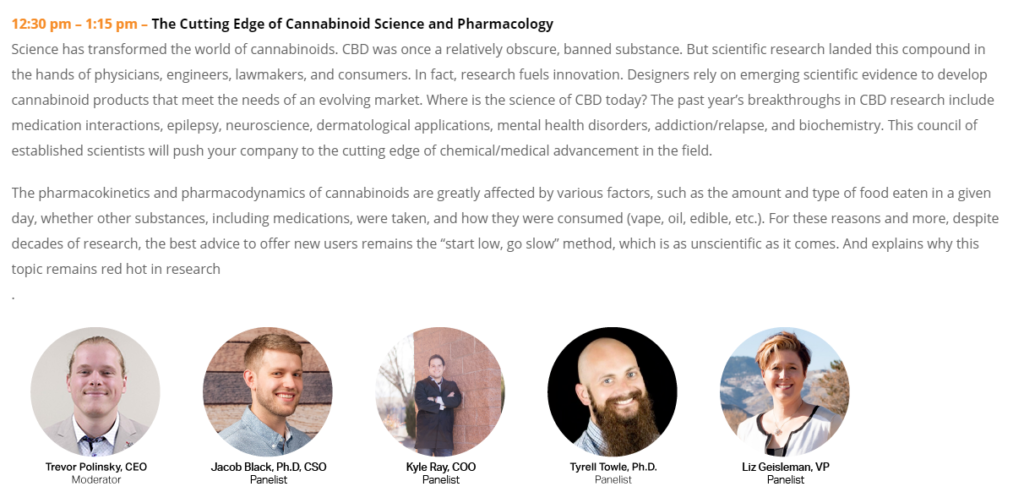
The following was a panel discussion on the new and upcoming science of minor and synthesized cannabinoids. Trevor Polinsky CEO of Soular Alchemy was the moderator with Jacob Black, Ph.D CSO at Treehouse Biotech, Kyle Ray COO at Colorado Chromatography, Tyrell Towle, Ph.D with MedPharm Holdings, and Liz Geisleman acting CEO with 710Spirits®as panelists.

Defining A Synthesized Cannabinoid
To give some background let’s define some terminology.
A. Synthesis
“Chemical synthesis, the construction of complex chemical compounds from simpler ones. It is the process by which many substances important to daily life are obtained. It is applied to all types of chemical compounds, but most syntheses are of organic molecules.”
B. Cannabinoids
Cannabinoids are “of various naturally-occurring, biologically active, chemical constituents of hemp or cannabis including some that possess psychoactive properties.” The cannabis plant makes over 100 cannabinoids, but many are found in very small amounts. Since such specific cannabinoids are found in such minor quantities, sometimes very potent chemicals have to be added to the mixture to break down the plant to reach and isolate those specific cannabinoids. it needs to be highly purified.
Some molecules/ cannabinoids will have the same effects but the issue of how you are extracting the cannabinoid can lead to byproducts that we have little to zero research or even knowledge in. Going through the extraction process to access those specific cannabinoids needs synthetic intermediates and therefore sometimes changes the chemical structure of the cannabinoid.
A+B=Synthesized Cannabinoid
Please be aware that synthesized compounds are not naturally found in the plant. Should the ethical compliancy of synthesized cannabinoids go under further investigation. For example “CBDQ is synthesized directly from hemp-derived CBD. CBDQ or Cannabidiol Hydroxy-Quinone has demonstrated to have a strong efficacy against human oncogenic (causing development of a tumor or tumorous) cells.” Colorado Chromatography. CBDQ is an example of a cannabinoid found naturally in the plant after oxidation, synthesized by the plant but not found in the plant processing cycle. Therefore getting a non natural potency.
While CBDQ is federally legal, with limited regulations in Florida and Wisconsin the longevity of legality for this synthesized cannabinoid is vexing. Synthesized cannabinoids can be naturally occurring but are not in high enough volumes to be synthesized when from the plant. It is the chemical that has been used to isolate the cannabinoid that is also then a part of the end product.
Enter synthetically derived cannabinoids such as delta-8, delta-10, THC-O-Acetate, etc.
Interaction With The Body
Endocannabinoid System
The endocannabinoid is a cell-signaling system found naturally in the body same as the endocrine or cardiovascular system. The endocannabinoid system is made of three components which are endocannabinoids, receptors and enzymes. Endo (meaning internally or within the body) cannabinoids are cannabinoids made in the body to regulate functions such as sleep, mood, appetite, etc.
Receptors are what the endocannabinoids bind to. Working as a relay message for an action needed to be taken in the body. The two main receptors are CB1, mostly found in the nervous system and initiates psychoactive effects. While CB2 are mostly found in the peripheral nervous system and have physiological effects such as CBD mitigating pain. THC interacts with the body by binding to both CB1 and CB2 receptors while CBD is believed to mitigate symptoms by preventing the breakdown of endocannabinoids. CBD mediates the receptors, keeping the endocannabinoids intact with tons of enzymes.
Enzymes then break down the endocannabinoids once they have carried out their function. To read more about the endocannabinoid system check out this great article here.
Subcategories
“Transient Receptor Potential (TRP) channels are a group of membrane proteins involved in the transduction of a plethora of chemical physical stimuli.” Basically (and I’m paraphrasing here I am not a scientist) TRP channels facilitate the transaction between the cell membrane that involves sensory stuff. TRP channels have six sub factors, while only three combine to CBD such as noise susceptor and pain from central to nervous system. Cannabinoids like CBN(Cannabinol) interacts with TRP channels and have calcium mediated input development which can help treat such illnesses as osteoporosis. TRP channels are naturally occurring and are being researched as an integral part of the endocannabinoid system. Frontiers in Molecular Neuroscience
Peroxisome Proliferator-Activated Receptors or PPARs are part of superfamily of hormone receptors also found in the endocannabinoid system. PPARs are thought to reduce triglyceride levels, insulin sensitivity and glucose metabolism. AKA helping those with diabetes, weight loss and inflammation. These are just some of the receptors and sub categories being discovered within the endocannabinoid systems and how they impact the human body. NCBI
Understanding the entirety of the this system will give us a better understanding of how synthetic and other plant cannabinoids will interact and provide medicinal help to those that need it. However its important to remember that the endocannabinoid system wasn’t discovered till the mid 90s. There is still a great deal unknown about the interaction and influence within the body. The inflammation response from body (stress, anxiety and skin) will still take decades to learn and understand.
Ethical and Moral Issue
The moral issue
The possibilities of synthesized cannabinoids can create an issue. Chemical modifications to create a specific action (cause and effect) or customized medicine can be incredibly beneficial. But the consumer still may have no idea what they are putting in their body. Especially if not properly labeled! Many consumers at this point don’t understand that these cannabinoids are not actually coming from the plant but have been synthesized into something else. Making it ethically wrong to label things such as “natural or organic”.
The innovation of the industry can be positive but the lack of third party testing and no set standards before being sold to the public is detrimental. Remember the Vitamin E Acetate vape crisis?
“Vitamin E Acetate is an oily chemical commonly added to THC vaping liquids to dilute or thicken them; the substance has been acknowledged as a potential toxin of concern by the Center for Disease Control and Prevention (CDC), due to its ability to remain in the lungs for long periods of time, and therefore cause complications in the lungs. ” NCBI
The cannabis industry has taken great strides to be safe, regulated and move away from the bad connotations and branding. Selfish acts born from innovation, such as the ones from the vape crisis, push the industry back three steps while many work tirelessly for one forward.
If not tested properly and approached with caution, experimentation can add to lives lost. For example THC-O-Acetate is technically legal through the Farm Bill because the compound is derived from hemp. (” Lab tests show that THC-O can be 300 percent stronger than regular THC. Yes, you read that right: 300 percent stronger.”) Read more about THC-O-Acetate here.
Legislative Response
However, this makes it incredibly difficult for legislators to regulate. Which in turn could unfortunately lead to legislators creating laws and rules as a knee jerk response. Making snap decisions instead of consulting with experts on the best way to move forward for the industry and society as a whole. Synthesized cannabinoids such as delta-8, vitamin E or THC-O-Acetate could ruin the Farm Bill of 2018. By simply having these products readily available, especially for children to buy with zero label warnings, puts the whole industry at risk.
The FDA has clear rules for synthetic compounds and those unclear on where they fall on the legal scale should check it out.
“The publication Approved Drug Products with Therapeutic Equivalence Evaluations (commonly known as the Orange Book) identifies drug products approved on the basis of safety and effectiveness by the Food and Drug Administration (FDA) under the Federal Food, Drug, and Cosmetic Act. (The Act) and related patent and exclusivity information.” FDA While expensive and time consuming, it can ensure the legitimacy and longevity of your product and brand. Purchasing from state regulated markets is also important. Hemp synthetics are regulated in the market place and have the accountability from the FDA and other regulators to adhere to.
Considering Pharmaceutical Compounds
There needs to be a structure and set of guidelines for synthetic cannabinoids. However, the possibility of having an entire category of prescriptions available over the counter from synthetic cannabinoids with doctor supervision is a slim possibility at this time. If a product is psychoactive you must deal with the DEA. If not psychoactive you have to define the toxicity level and whether it can fall under the FDA vitamin or dietary supplement realm. You must prove the level of toxicity as defined as a dietary ingredient or food NOT a drug. But categorizing something as synthetic will need a new form of licenser to ensure the quality and legitimacy of the product.
Best Practices
Testing for impurities and toxins in a batch to stay compliant within the laws of the land are essential. A person that consumes a products that is not properly synthesized puts them at great risk. With no way of knowing how it will exactly interact with the body. Make sure that every product you produce is food grade verified quality with established vendors to create a product that is safe for the public. Read more about being FDA compliant here.
The entire supply chain needs to be aware and compliant, from vendors, equipment used, and correct disposal of chemicals. Many that are pro-drug aim to increase psych activity. The issue with this is the level of activity is not comparable to current drug levels. For example, while a synthetic compound might help an Alzheimer’s patient with stress. They wouldn’t want to deal with the strong psychoactive effects as well.
Watch out for forged CofAs (Certificates of Analysis) and have a vetted third party source to test your bulk chemistry. The DEA has strong rules on synthesized cannabinoids. “For synthetically derived tetrahydrocannabinols, the concentration of D9 -THC is not a determining factor in whether the material is a controlled substance. All synthetically derived tetrahydrocannabinols remain schedule I controlled substances.” Harris Bricken
What We Need
We as an industry must be cautious moving forward. And while innovation is incredibly ample, without regulatory hurdles and self imposing standards it hinders the longevity and legitimacy of the industry. Being open to the idea of creating drugs when they are of the safest and highest quality ensures the long term future of cannabinoids. Helping many in holistic ways that other drugs currently can’t do.
Works Cited
“Blog.” Colorado Chromatography, coloradochromatography.com/blog/
Boudi, F Brian, et al. “Vitamin E Acetate as a Plausible Cause of Acute Vaping-Related Illness.” Cureus, 2019, doi:10.7759/cureus.6350.
“Cannabinoid.” Merriam-Webster, Merriam-Webster, www.merriam-webster.com/dictionary/cannabinoid.
Carter, Alan, and Crystal Raypole. “A Simple Guide to the Endocannabinoid System.” Healthline, 17 May 2019, www.healthline.com/health/endocannabinoid-system.
“Chemical Synthesis.” Encyclopædia Britannica, Encyclopædia Britannica, Inc., www.britannica.com/science/chemical-synthesis.
Franciosi, Anthony. “THC-O-Acetate: What It Is And What You Need To Know About It.” Honest Marijuana, 25 Oct. 2019, honestmarijuana.com/thc-o/.
Jikomes, Nick. “A List of Major Cannabinoids in Cannabis and Their Effects.” Leafly, 26 Jan. 2021, www.leafly.com/news/cannabis-101/list-major-cannabinoids-cannabis-effects.
Muller, Chanté, et al. “Cannabinoid Ligands Targeting TRP Channels.” Frontiers in Molecular Neuroscience, vol. 11, 2019, doi:10.3389/fnmol.2018.00487.
Russo, Ethan B. “Clinical Endocannabinoid Deficiency Reconsidered: Current Research Supports the Theory in Migraine, Fibromyalgia, Irritable Bowel, and Other Treatment-Resistant Syndromes.” Cannabis and Cannabinoid Research, vol. 1, no. 1, 2016, pp. 154–165., doi:10.1089/can.2016.0009.
Storozhuk, Maksim V., and Alexander V. Zholos. “TRP Channels as Novel Targets for Endogenous Ligands: Focus on Endocannabinoids and Nociceptive Signalling.” Current Neuropharmacology, vol. 16, no. 2, 2018, doi:10.2174/1570159×15666170424120802.
“Transient Receptor Potential Channel.” Encyclopædia Britannica, Encyclopædia Britannica, Inc., www.britannica.com/science/transient-receptor-potential-channel.
Tyagi, Sandeep, et al. “The Peroxisome Proliferator-Activated Receptor: A Family of Nuclear Receptors Role in Various Diseases.” Journal of Advanced Pharmaceutical Technology & Research, vol. 2, no. 4, 2011, p. 236., doi:10.4103/2231-4040.90879.

Teagan is the Marketing & Communications Manager for 710Spirits® and Rocky Mountain Reagents. While continually learning about the cannabis industry and all the possibilities it has to offer she creates content for The Canna Consortium both for blog posts and social media. Make sure to check out @thecannaconsortium2.0 for all industry updates and news.
